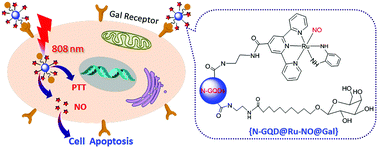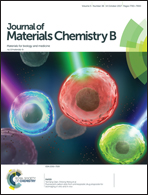A ruthenium-nitrosyl-functionalized nanoplatform for the targeting of liver cancer cells and NIR-light-controlled delivery of nitric oxide combined with photothermal therapy†
Abstract
The development of light-controlled nitric oxide (NO)-releasing nanoplatforms that are capable of specifically targeting liver cancer cell lines and delivering an optimal amount of NO can significantly affect liver cancer therapy. In this study, a multifunctional nanoplatform {N-GQDs@Ru-NO@Gal} (1) for the near-infrared (NIR) light-responsive release of NO, consisting of a NO donor (Ru-NO) and a liver-targeting galactose derivative (Gal) covalently attached to N-doped graphene quantum dots (N-GQDs), was reported. Nanoplatform 1 preferentially targeted liver cancer cells over normal cells and instantly released NO as well as exhibited a prominent photothermal effect upon NIR irradiation at 808 nm, thereby leading to efficient anti-tumor efficacy. {N-GQDs@Ru-NO@Gal} with a small size (<10 nm), good biocompatibility, and fluorescent-tracing properties represents a unique example of a multifunctional NO-releasing nanoplatform that combines photodynamic and photothermal therapies for the targeted treatment of liver cancer. Hence, the developed nanoplatform demonstrates potential for applications in NO-mediated multimodal phototherapy in the near future.



 Please wait while we load your content...
Please wait while we load your content...